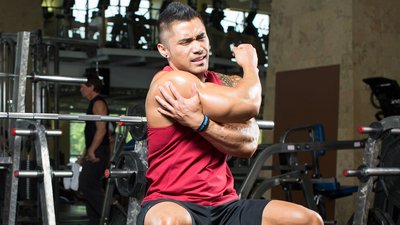Remember the last time you strained your lower back doing a heavy set of curls? Or that nagging elbow pain that reappears every time you train biceps? Or even that muscle soreness you experienced a couple of days after that monster leg workout?
Weightlifters, like many other athletes, often suffer injuries to muscles, tendons, ligaments, or other soft tissues. Some injuries come and go in relatively short order. Other injuries hang around—they never quite heal and are easily aggravated by further activity. But whether an injury is acute or chronic, it requires quick and proper care if you want to minimize your downtime.
Some of the more commonly prescribed treatments are the application of cold and ice (cryotherapy) or heat (thermotherapy). Since these treatment methods don't require a medical prescription and are easily accessible with minimal risks, athletes use them frequently.
The question is, which is best for a given injury: heat or cold?

How Pain Signals Work
When tissue is damaged, nerves send messages to the brain that are perceived as pain. Simultaneously, chemical messengers known as neurotransmitters begin a reflex that may lead to muscle spasms in the surrounding area. These spasms can potentially cause more tissue damage because of decreased blood flow to the area, and that can create more pain.[1] The pain-spasm-pain cycle continues and can increase the degree of pain. It can also decrease mobility, sometimes markedly.
To prevent further injury and pain, you'll need to jump into action. Both hot and cold treatments are effective at reducing pain and muscle spasms.[1] They both stimulate temperature-sensitive nerve endings, inhibiting the transmission of pain signals to the brain. Although both heat and ice can help block the pain-spasm-pain cycle, each provides an opposite effect on tissue metabolism, blood flow, inflammation, edema (swelling caused by excess fluid), the speed of nerve impulses (nerve conduction velocity), and your muscles' ability to stretch.
When and How to Use Cold
Effective cryotherapy should decrease the tissue temperature 2-4 centimeters (about an inch or more) below the skin by 18-27 degrees F.[2] This causes a narrowing of the blood vessels, and the resulting decrease in blood flow reduces tissue metabolism, oxygen use, edema, and inflammation.[3] Nerve conduction slows down, while tolerance of pain goes up.[4]
Despite its effects on blood flow and inflammation, limited research exists supporting its use in the management of acute injuries or delayed-onset muscle soreness (DOMS).[3] Furthermore, there's a lack of evidence suggesting it can be a useful tool in speeding up recovery time.[5]

How to Use
Ice bags, cold packs, frozen veggies, and direct-contact ice massage are commonly used. Finely crushed ice in a large bag or frozen veggies are easy to use and mold to your body's contours. Ice packs also work well and may also mold. Direct-contact ice massage penetrates quickly and deeply, but it isn't suitable for all individuals or circumstances.
Icing is typically uncomfortable for the first 3-5 minutes, but it should never be unbearable. Treatment time should last 15-20 minutes; however, direct-contact ice massage should be applied for only 5-10 minutes. Cold therapy may be re-applied every two hours. A thin layer of fabric, such as a pillow case, should be used between the skin and the cold pack.
When to Use
Apply cold within 48-72 hours of acute trauma to any body part except the low back. It can also be used for the management of chronic pain after activity (like a baseball pitcher after the game) and inflammation such as swelling. Do not use cold if you have overly sensitive skin (eczema, dermatitis) or areas of poor circulation. Be especially careful when treating areas with poor blood flow, if you have known cold allergies, or if you have advanced diabetes. A lack of sensation resulting from diabetes-related nerve damage could lead to an excessive application of cold.
When and How to Use Heat
Thermotherapy increases tissue temperature, causing vasodilation, or widening of the blood vessels, which can increase blood flow to the injured area.[3] Research suggests increased blood flow improves tissue healing by supplying oxygen, protein, and nutrients to the site of the injury.[1]
As with cryotherapy, there's limited evidence supporting the claims that heat therapy is effective at improving an athlete's return to participation. But research has shown positive findings on the efficacy of thermotherapy for pain relief in patients with acute low-back pain.[6]

How to Use
Dry heat packs, moist hot packs, or hot baths can be used. Localized moist heat tends to penetrate better and may avoid drying your skin. The heat should be warm but tolerable—not too hot. It's best to maintain a consistent temperature during treatment. It's recommended that tissue temperature reach 104-113 degrees F (40-45 degrees C). Treatment time should last 15-30 minutes, depending on tissue thickness and type of injury.
Areas with thicker tissue, more spasticity, or both may require up to 30 minutes. Heat may be re-applied every two hours. Layers should be used to avoid burning your skin. Alternating between heat and cold has not been shown to be conclusively effective.[7]
When to Use
Apply heat for acute low-back pain (short-term injury), injuries persisting for longer than 72 hours, relief of muscle spasms where inflammation is not present, and menstrual pain. Do not use immediately after exercise except for low-back pain and injuries where inflammation is present. Use special precautions when treating individuals with diabetes, spinal-cord injuries, and multiple sclerosis. Nerve damage from those diseases can lead to the overapplication of heat.
Remember, injuries that continue to prohibit the performance of normal activities should be followed up with a visit to a qualified health-care professional such as a physician, certified athletic trainer, or physical therapist. These injuries must be properly assessed and treated so that they don't worsen. Self-treatment via the use of thermotherapy, cryotherapy, or both is effective for the short term but not the long term.
References
- Nadler, S. F., Weingand, K., & Kruse, R. J. (2004). The physiologic basis and clinical applications of cryotherapy and thermotherapy for the pain practitioner. Pain Physician, 7(3), 395-400.
- Galiuto, L. (2016). The use of cryotherapy in acute sports injuries. Annals of Sports Medicine and Research, 3(2), 1060.
- Malanga, G. A., Yan, N., & Stark, J. (2015). Mechanisms and efficacy of heat and cold therapies for musculoskeletal injury. Postgraduate Medicine, 127(1), 57-65.
- Algafly, A. A., & George, K. P. (2007). The effect of cryotherapy on nerve conduction velocity, pain threshold and pain tolerance. British Journal of Sports Medicine, 41(6), 365-369.
- Hubbard, T. J., Aronson, S. L., & Denegar, C. R. (2004). Does cryotherapy hasten return to participation? A systematic review. Journal of Athletic Training, 39(1), 88.
- Dehghan, M., & FarahbOD, F. (2014). The efficacy of thermotherapy and cryotherapy on pain relief in patients with acute low back pain, a clinical trial study. Journal of Clinical and Diagnostic Research, 8(9), 1-4.
- Stanton, D. E. B., Lazaro, R., & MacDermid, J. C. (2009). A systematic review of the effectiveness of contrast baths. Journal of Hand Therapy, 22(1), 57-70.



